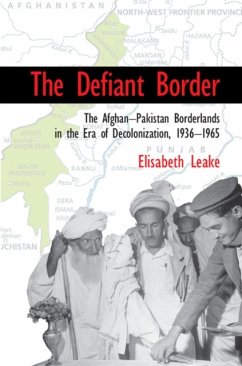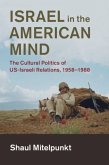Elisabeth Leake (University of Leeds)
The Defiant Border
Elisabeth Leake (University of Leeds)
The Defiant Border
- Broschiertes Buch
- Merkliste
- Auf die Merkliste
- Bewerten Bewerten
- Teilen
- Produkt teilen
- Produkterinnerung
- Produkterinnerung
The Defiant Border explores why the Afghan-Pakistan borderlands have remained largely independent of state controls from the colonial period into the twenty-first century. It will appeal to scholars of South Asia, decolonization, and the Cold War and to general readers seeking historical context for the 'war on terror' in Afghanistan.
Andere Kunden interessierten sich auch für
![Israel in the American Mind Israel in the American Mind]() Shaul Mitelpunkt (University of York)Israel in the American Mind52,99 €
Shaul Mitelpunkt (University of York)Israel in the American Mind52,99 €![The Defiant Heir The Defiant Heir]() Melissa CarusoThe Defiant Heir18,99 €
Melissa CarusoThe Defiant Heir18,99 €![Rogue Diplomats Rogue Diplomats]() Seth Jacobs (Massachusetts Boston College)Rogue Diplomats26,99 €
Seth Jacobs (Massachusetts Boston College)Rogue Diplomats26,99 €![The Clinician's Guide to Oppositional Defiant Disorder The Clinician's Guide to Oppositional Defiant Disorder]() Michelle M. MartelThe Clinician's Guide to Oppositional Defiant Disorder75,99 €
Michelle M. MartelThe Clinician's Guide to Oppositional Defiant Disorder75,99 €![The Defiant Middle The Defiant Middle]() Kaya OakesThe Defiant Middle21,99 €
Kaya OakesThe Defiant Middle21,99 €![The Teacher's Guide to Oppositional Defiant Disorder The Teacher's Guide to Oppositional Defiant Disorder]() Amelia BowlerThe Teacher's Guide to Oppositional Defiant Disorder33,99 €
Amelia BowlerThe Teacher's Guide to Oppositional Defiant Disorder33,99 €![Science and American Foreign Relations since World War II Science and American Foreign Relations since World War II]() Greg Whitesides (Denver University of Colorado)Science and American Foreign Relations since World War II45,99 €
Greg Whitesides (Denver University of Colorado)Science and American Foreign Relations since World War II45,99 €-
-
-
The Defiant Border explores why the Afghan-Pakistan borderlands have remained largely independent of state controls from the colonial period into the twenty-first century. It will appeal to scholars of South Asia, decolonization, and the Cold War and to general readers seeking historical context for the 'war on terror' in Afghanistan.
Hinweis: Dieser Artikel kann nur an eine deutsche Lieferadresse ausgeliefert werden.
Hinweis: Dieser Artikel kann nur an eine deutsche Lieferadresse ausgeliefert werden.
Produktdetails
- Produktdetails
- Cambridge Studies in US Foreign Relations
- Verlag: Cambridge University Press
- Seitenzahl: 272
- Erscheinungstermin: 24. Dezember 2016
- Englisch
- Abmessung: 228mm x 151mm x 20mm
- Gewicht: 420g
- ISBN-13: 9781107571563
- ISBN-10: 1107571561
- Artikelnr.: 44989806
- Herstellerkennzeichnung
- Libri GmbH
- Europaallee 1
- 36244 Bad Hersfeld
- gpsr@libri.de
- Cambridge Studies in US Foreign Relations
- Verlag: Cambridge University Press
- Seitenzahl: 272
- Erscheinungstermin: 24. Dezember 2016
- Englisch
- Abmessung: 228mm x 151mm x 20mm
- Gewicht: 420g
- ISBN-13: 9781107571563
- ISBN-10: 1107571561
- Artikelnr.: 44989806
- Herstellerkennzeichnung
- Libri GmbH
- Europaallee 1
- 36244 Bad Hersfeld
- gpsr@libri.de
Elisabeth Leake is a Lecturer in International History at the University of Leeds. She previously held a Leverhulme Early Career Fellowship at Royal Holloway, University of London. She has published articles in The Historical Journal, Modern Asian Studies, and The International History Review. She is coeditor, alongside Leslie James, of Decolonization and the Cold War: Negotiating Independence (2015), and has coedited a special issue of Contemporary South Asia on South Asia's 'wider worlds'.
Introduction. 'A doughty and honorable opponent': historicizing the Afghan-Pakistan borderlands
1. The Pashtun tribes
2. Geopolitics and state-building
3. Book structure
Part I. 'Using a Crowbar to Swat Wasps': The Frontier Tribal Area in Imperial Defense: 4. India in interwar British imperial strategy
5. Indian nationalism, the Indian army, and regional relations
6. The 1936-7 revolt and its aftermath
7. Indian nationalists, the subcontinent's defense, and the war effort
8. The Pashtuns and the war effort
9. Conclusion
Part II. The 'Opening of Sluice Gates': Plan Partition and the Frontier: 10. The end of war, imperial decline, and plan partition
11. Reconciling independent South Asia and imperial defense
12. The NWFP and the 1945-6 elections
13. British policy towards the frontier tribal area
14. Nehru's visit to the frontier and the local decline of the congress
15. Afghanistan, regional relations, and India's Pashtuns
16. The NWFP referendum and the future of the tribal zone
17. Independence and evolving tribal identity
18. Pakistan and the frontier tribal area
19. Conclusion
Part III. 'We are One People and Ours is a Land': The Demand for Pashtunistan, 1948-52: 20. Britain, the emerging Cold War, and the Kashmir conflict
21. Kashmir in Indio-Pakistan relations
22. The development of independent Pakistan
23. The rise of Afghan-Pakistan tensions
24. Pakistan and the frontier tribal area
25. Pashtunistan in regional and international relations
26. Conclusion
Part IV. A 'Friendly Point of Return': Pakistan and the Global Cold War: 27. The emergence of the United States-Pakistan alliance
28. The impasse in Afghan-Pakistan relations
29. The frontier tribal area and the one unit plan
30. Renegotiating Afghan-Pakistan relations in the Cold War
31. Conclusion
Part V. An 'Eye for an Eye': Mohammad Ayub Khan and the Collapse of Regional Relations: 32. India and the United States: democracies reunited
33. Ayub Khan's ascendancy
34. Domestic change and integrating borderlands
35. Daud and Afghan modernization
36. Violence returns to the borderlands
37. The 1960 Afghan-Pakistan rupture
38. The failure of US mediation
39. The aftermath of the encounter
40. Conclusion
Part VI. Conclusion. 'Religion, Land, Lineage, and Honour': The Afghan-Pakistan Borderlands Then and Now: 41. Pashtunistan then and now.
1. The Pashtun tribes
2. Geopolitics and state-building
3. Book structure
Part I. 'Using a Crowbar to Swat Wasps': The Frontier Tribal Area in Imperial Defense: 4. India in interwar British imperial strategy
5. Indian nationalism, the Indian army, and regional relations
6. The 1936-7 revolt and its aftermath
7. Indian nationalists, the subcontinent's defense, and the war effort
8. The Pashtuns and the war effort
9. Conclusion
Part II. The 'Opening of Sluice Gates': Plan Partition and the Frontier: 10. The end of war, imperial decline, and plan partition
11. Reconciling independent South Asia and imperial defense
12. The NWFP and the 1945-6 elections
13. British policy towards the frontier tribal area
14. Nehru's visit to the frontier and the local decline of the congress
15. Afghanistan, regional relations, and India's Pashtuns
16. The NWFP referendum and the future of the tribal zone
17. Independence and evolving tribal identity
18. Pakistan and the frontier tribal area
19. Conclusion
Part III. 'We are One People and Ours is a Land': The Demand for Pashtunistan, 1948-52: 20. Britain, the emerging Cold War, and the Kashmir conflict
21. Kashmir in Indio-Pakistan relations
22. The development of independent Pakistan
23. The rise of Afghan-Pakistan tensions
24. Pakistan and the frontier tribal area
25. Pashtunistan in regional and international relations
26. Conclusion
Part IV. A 'Friendly Point of Return': Pakistan and the Global Cold War: 27. The emergence of the United States-Pakistan alliance
28. The impasse in Afghan-Pakistan relations
29. The frontier tribal area and the one unit plan
30. Renegotiating Afghan-Pakistan relations in the Cold War
31. Conclusion
Part V. An 'Eye for an Eye': Mohammad Ayub Khan and the Collapse of Regional Relations: 32. India and the United States: democracies reunited
33. Ayub Khan's ascendancy
34. Domestic change and integrating borderlands
35. Daud and Afghan modernization
36. Violence returns to the borderlands
37. The 1960 Afghan-Pakistan rupture
38. The failure of US mediation
39. The aftermath of the encounter
40. Conclusion
Part VI. Conclusion. 'Religion, Land, Lineage, and Honour': The Afghan-Pakistan Borderlands Then and Now: 41. Pashtunistan then and now.
Introduction. 'A doughty and honorable opponent': historicizing the Afghan-Pakistan borderlands
1. The Pashtun tribes
2. Geopolitics and state-building
3. Book structure
Part I. 'Using a Crowbar to Swat Wasps': The Frontier Tribal Area in Imperial Defense: 4. India in interwar British imperial strategy
5. Indian nationalism, the Indian army, and regional relations
6. The 1936-7 revolt and its aftermath
7. Indian nationalists, the subcontinent's defense, and the war effort
8. The Pashtuns and the war effort
9. Conclusion
Part II. The 'Opening of Sluice Gates': Plan Partition and the Frontier: 10. The end of war, imperial decline, and plan partition
11. Reconciling independent South Asia and imperial defense
12. The NWFP and the 1945-6 elections
13. British policy towards the frontier tribal area
14. Nehru's visit to the frontier and the local decline of the congress
15. Afghanistan, regional relations, and India's Pashtuns
16. The NWFP referendum and the future of the tribal zone
17. Independence and evolving tribal identity
18. Pakistan and the frontier tribal area
19. Conclusion
Part III. 'We are One People and Ours is a Land': The Demand for Pashtunistan, 1948-52: 20. Britain, the emerging Cold War, and the Kashmir conflict
21. Kashmir in Indio-Pakistan relations
22. The development of independent Pakistan
23. The rise of Afghan-Pakistan tensions
24. Pakistan and the frontier tribal area
25. Pashtunistan in regional and international relations
26. Conclusion
Part IV. A 'Friendly Point of Return': Pakistan and the Global Cold War: 27. The emergence of the United States-Pakistan alliance
28. The impasse in Afghan-Pakistan relations
29. The frontier tribal area and the one unit plan
30. Renegotiating Afghan-Pakistan relations in the Cold War
31. Conclusion
Part V. An 'Eye for an Eye': Mohammad Ayub Khan and the Collapse of Regional Relations: 32. India and the United States: democracies reunited
33. Ayub Khan's ascendancy
34. Domestic change and integrating borderlands
35. Daud and Afghan modernization
36. Violence returns to the borderlands
37. The 1960 Afghan-Pakistan rupture
38. The failure of US mediation
39. The aftermath of the encounter
40. Conclusion
Part VI. Conclusion. 'Religion, Land, Lineage, and Honour': The Afghan-Pakistan Borderlands Then and Now: 41. Pashtunistan then and now.
1. The Pashtun tribes
2. Geopolitics and state-building
3. Book structure
Part I. 'Using a Crowbar to Swat Wasps': The Frontier Tribal Area in Imperial Defense: 4. India in interwar British imperial strategy
5. Indian nationalism, the Indian army, and regional relations
6. The 1936-7 revolt and its aftermath
7. Indian nationalists, the subcontinent's defense, and the war effort
8. The Pashtuns and the war effort
9. Conclusion
Part II. The 'Opening of Sluice Gates': Plan Partition and the Frontier: 10. The end of war, imperial decline, and plan partition
11. Reconciling independent South Asia and imperial defense
12. The NWFP and the 1945-6 elections
13. British policy towards the frontier tribal area
14. Nehru's visit to the frontier and the local decline of the congress
15. Afghanistan, regional relations, and India's Pashtuns
16. The NWFP referendum and the future of the tribal zone
17. Independence and evolving tribal identity
18. Pakistan and the frontier tribal area
19. Conclusion
Part III. 'We are One People and Ours is a Land': The Demand for Pashtunistan, 1948-52: 20. Britain, the emerging Cold War, and the Kashmir conflict
21. Kashmir in Indio-Pakistan relations
22. The development of independent Pakistan
23. The rise of Afghan-Pakistan tensions
24. Pakistan and the frontier tribal area
25. Pashtunistan in regional and international relations
26. Conclusion
Part IV. A 'Friendly Point of Return': Pakistan and the Global Cold War: 27. The emergence of the United States-Pakistan alliance
28. The impasse in Afghan-Pakistan relations
29. The frontier tribal area and the one unit plan
30. Renegotiating Afghan-Pakistan relations in the Cold War
31. Conclusion
Part V. An 'Eye for an Eye': Mohammad Ayub Khan and the Collapse of Regional Relations: 32. India and the United States: democracies reunited
33. Ayub Khan's ascendancy
34. Domestic change and integrating borderlands
35. Daud and Afghan modernization
36. Violence returns to the borderlands
37. The 1960 Afghan-Pakistan rupture
38. The failure of US mediation
39. The aftermath of the encounter
40. Conclusion
Part VI. Conclusion. 'Religion, Land, Lineage, and Honour': The Afghan-Pakistan Borderlands Then and Now: 41. Pashtunistan then and now.








